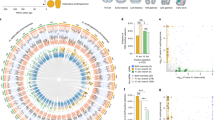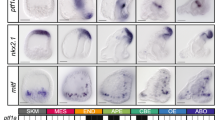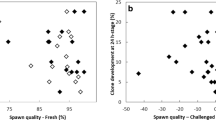Abstract
Microinjection of amphibian oocytes with purified cloned DNA has proven to be a valuable assay system for studying eukaryotic gene expression1–13. The oocyte's ability to express microinjected genes has already allowed a functional analysis of several genes and their sequence manipulated counterparts14–20. Although such studies are now possible with several other expression systems, the oocyte system is unique in that it represents a cell destined, on fertilization, to divide and differentiate into an embryo. Thus, it was envisaged that the technique of microinjecting genes and their mutant analogues into fertilized eggs might eventually be used as an assay system for studying the transcriptional control processes that occur during cell differentiation and development. To this end, fertilized eggs of Xenopus laevis were injected with a cloned repeat of sea urchin histone genes and the fate and expression of the injected genes examined during the early stages of Xenopus development. After replication during the early cleavage stages, the injected sea urchin histone DNA sequences persisted to at least the swimming tadpole stage. The injected genes were also at least in part faithfully transcribed into RNA species with the correct histone mRNA 5′ and 3′ termini. Thus, these results, reported here, meet the prerequisites for an assay system capable of being used to investigate the factors involved in the developmental control of gene activity.
This is a preview of subscription content, access via your institution
Access options
Subscribe to this journal
Receive 51 print issues and online access
$199.00 per year
only $3.90 per issue
Buy this article
- Purchase on SpringerLink
- Instant access to full article PDF
Prices may be subject to local taxes which are calculated during checkout
Similar content being viewed by others
References
Kressmann, A., Clarkson, S. G., Telford, J. L. & Birnstiel, M. L. Cold Spring Harb. Symp. quant. Biol. 42, 1077 (1977).
Kressmann, A., Clarkson, S. G., Pirrotta, V. & Birnstiel, M. L. Proc. natn. Acad. Sci. U.S.A. 75, 1176 (1978).
Cortese, R., Melton, D., Tranquilla, T. & Smith, J. O. Nucleic Acids Res. 5, 4593 (1978).
De Robertis, E. M. & Olson, M. V. Nature 278, 137 (1979).
Brown, D. D. & Gurdon, J. B. Proc. natn. Acad. Sci. U.S.A. 75, 2849 (1978).
Probst, E., Kressmann, A. & Birnstiel, M. L. J. molec. Biol. 135, 709 (1979).
Hentschel, C., Probst, E. & Birnstiel, M. L. Nature 288, 100 (1980).
Trendelenburg, M. F. & Gurdon, J. B. Nature 276, 292 (1978).
Trendelenburg, M. F., Mathis, D. & Oudet, P. Proc. natn. Acad. Sci. U.S.A. 77, 5984 (1980).
Etkin, L. D. & Maxson, R. E. Devl Biol. 75, 13 (1980).
Wickens, M. P., Woo, S., O'Malley, B. W. & Gurdon, J. B. Nature 285, 628 (1980).
DeRobertis, E. M. & Mertz, J. E. Cell 12, 175 (1977).
Rungger, D. & Türler, H. Proc. natn. Acad. Sci. U.S.A. 75, 6073 (1978).
Kressmann, A., Hofstetter, H., Di Capua, E., Grosschedl, R. & Birnstiel, M. L. Nucleic Acids Res. 7, 1749 (1979).
Hofstetter, H., Kressmann, A. & Birnstiel, M. L. Cell 24, 573 (1981).
DeFranco, D., Schmit, O. & Söll, D. Proc. natn. Acad. Sci. U.S.A. 77, 3365 (1980).
Sakonju, S., Bogenhagen, D. F. & Brown, D. D. Cell 19, 13 (1980).
Bogenhagen, D. F., Sakonju, S. & Brown, D. D. Cell 19, 27 (1980).
Grosschedl, R. & Birnstiel, M. L. Proc. natn. Acad. Sci. U.S.A. 77, 1432 (1980).
Grosschedl, R. & Birnstiel, M. L. Proc. natn. Acad. Sci. U.S.A. 77, 7102 (1980).
Clarkson, S. G., Smith, H. O., Schaffner, W., Gross, K. W. & Birnstiel, M. L. Nucleic Acids Res. 3, 2617 (1976).
Gross, K., Schaffner, W., Telford, J. & Birnstiel, M. L. Cell 8, 479 (1976).
Harland, R. M. & Laskey, R. A. Cell 21, 761 (1980).
Clerc, R. thesis, Univ. Zürich (1980).
Wyllie, A. H., Laskey, R. A., Finch, J. & Gurdon, J. B. Devl Biol. 64, 178 (1978).
Hentschel, C., Irminger, J. C., Bucher, P. & Birnstiel, M. L. Nature 285, 147 (1980).
Rusconi, S. & Schaffner, W. Proc. natn. Acad. Sci. U.S.A. (in the press).
Korn, L. J. & Gurdon, J. B. Nature 289, 461 (1981).
Billett, F. S. & Wild, A. E. Practical Studies of Animal Development, 119–127 (Chapman & Hall, London, 1975).
Gurdon, J. B. & Brown, D. D. in The Molecular Biology of the Mammalian Gene Apparatus (ed. Tso, P.) 111–123 (Elsevier, Amsterdam, 1977).
Nieuwkoop, P. D. & Farber, J. Normal Table of Xenopus laevis (Daudin) (North-Holland, Amsterdam, 1967).
Wahl, G. M., Stern, M. & Stark, G. R. Proc. natn. Acad. Sci. U.S.A. 76, 3683 (1979).
Southern, E. M. J. molec. Biol. 98, 503 (1975).
Berk, A. J. & Sharp, P. A. Proc. natn. Acad. Sci. U.S.A. 75, 1274 (1978).
Author information
Authors and Affiliations
Rights and permissions
About this article
Cite this article
Bendig, M. Persistence and expression of histone genes injected into Xenopus eggs in early development. Nature 292, 65–67 (1981). https://doi.org/10.1038/292065a0
Received:
Accepted:
Issue date:
DOI: https://doi.org/10.1038/292065a0
This article is cited by
-
Foreign gene transfer into Chinese shrimps (Penaeus chinensis) with gene gun
Chinese Science Bulletin (2001)
-
Temporally uncontrolled expression of linearized plasmid DNA which carries bacterial chloramphenicol acetyltransferase gene withXenopus cardiacα-actin promoter after injection intoXenopus fertilized eggs
Roux's Archives of Developmental Biology (1990)
-
Replication of plasmid DNA in fertilized Xenopus eggs is sensitive to both the topology and size of the injected template
Chromosoma (1989)
-
Expression of circular and linearized bacterial chloramphenicol acetyltransferase genes with or without viral promoters after injection into fertilized eggs, unfertilized eggs and oocytes ofXenopus laevis
Roux’s Archives of Developmental Biology (1989)



